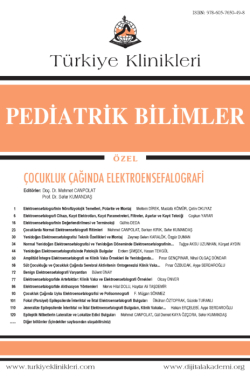Abnormal Findings in Neonatal Electroencephalography
Erdem ŞİMŞEKa, Hasan TEKGÜLa
aÇocuk Nörolojisi BD, Ege Üniversitesi Tıp Fakültesi, İzmir, TÜRKİYE
Şimşek E, Tekgül H. Yenidoğan elektroensefalografisinde patolojik bulgular. Canpolat M, Kumandaş S, editörler. Çocukluk Çağında Elektroensefalografi. 1. Baskı. Ankara: Türkiye Klinikleri; 2019. p.44-9.
ABSTRACT
The electroencephalography (EEG) of the neonatal period differs significantly from the EEG of the older child and adult. The electrical activity also varies depending on the conceptual age reflecting the maturation of the brain. This variability presents various evaluation challenges for neurologists. In this article, pathological findings (ground rhythm abnormalities and paroxysmal abnormalities) of EEG in newborn period are described.
Keywords: Electroencephalography; prognostic classification; newborn
Kaynak Göster
Referanslar
- Pisani F, Copioli C, Di Gioia C, Turco E, Sisti L. Neonatal seizures: relation of ictal videoelectroencephalography (EEG) findings with neurodevelopmental outcome. J Child Neurol. 2008;23(4):394-8. [Crossref] [PubMed]
- Tharp BR. Electrophysiological brain maturation in premature infants: an historical perspective. J Clin Neurophysiol. 1990;7(3): 302-14. [Crossref] [PubMed]
- Dreyfus-Brisac C. The electroencephalogram of the premature infant. World Neurol. 1962;3:5-15.
- Watanabe K, Hayakawa F, Okumura A. Neonatal EEG: a powerful tool in the assessment of brain damage in preterm infants. Brain Dev. 1999;21(6):361-72. [Crossref] [PubMed]
- Dreyfus-Brisac C. The electroencephalogram of the premature infant and full-term new bone: normal and abnormal development of waking and sleeping patterns. Neurol & EEG Correl Studies in Infancy. 1964;186-207.
- Holmes GL, Lombroso CT. Prognostic value of background patterns in the neonatal EEG. J Clin Neurophysiol. 1993;10(3):323-52. [Crossref] [PubMed]
- Britton JW, Frey LC, Hopp JL, Korb P, Koubeissi MZ, Lievens WE, et al. Electroencephalography (EEG): an introductory text and atlas of normal and abnormal findings in adults, children, and infants. Chicago: American Epilepsy Society; 2016.
- Selton D, Andre M, Hascoët JM. Normal EEG in very premature infants: reference criteria. Clin Neurophysiol. 2000;111(12):2116-24. [Crossref] [PubMed]
- Hahn JS, Monyer H, Tharp BR. Interburst interval measurements in the EEGs of premature infants with normal neurological outcome. Electroencephalogr Clin Neurophysiol. 1989;73(5):410-8. [Crossref] [PubMed]
- Polat M, Simşek A, Tansuğ N, Sezer RG, Ozkol M, Başpınar P, et al. Prediction of neurodevelopmental outcome in term neonates with hypoxic-ischemic encephalopathy. Eur J Paediatr Neurol. 2013;17(3):288-93. [Crossref] [PubMed]
- Tekgul H, Gauvreau K, Soul J, Murphy L, Robertson R, Stewart J, et al. The current etiologic profile and neurodevelopmental outcome of seizures in term newborn infants. Pediatrics. 2006;117(4):1270-80. [Crossref] [PubMed]
- Blume WT, Dreyfus-Brisac C. Positive rolandic sharp waves in neonatal EEG; types and significance. Electroencephalogr Clin Neurophysiol. 1982;53(3):277-82. [Crossref] [PubMed]
- da Costa J, Lombroso CT. Neurophysiological correlates of neonatal intracranial hemorrhage. Electroencephalogr Clin Neurophysiol. 1980;50:183-4.
- Oliveira AJ, Nunes ML, Haertel LM, Reis FM, da Costa JC. Duration of rhythmic EEG patterns in neonates: new evidence for clinical and prognostic significance of brief rhythmic discharges. Clin Neurophysiol. 2000;111(9): 1646-53. [Crossref] [PubMed]
- Scher MS, Aso K, Beggarly ME, Hamid MY, Steppe DA, Painter MJ. Electrographic seizures in preterm and full-term neonates: clinical correlates, associated brain lesions, and risk for neurologic sequelae. Pediatrics. 1993;91(1):128-34. [Crossref] [PubMed]
- Aicardi J, Goutieres F. [Neonatal myoclonic encephalopathy (author's transl)]. Rev Electroencephalogr Neurophysiol Clin. 1978;8(1): 99-101. [Crossref] [PubMed]
- Otahara S, Ishida T, Oka E. On the specific age-dependent epileptic syndrome. The early infantile epileptic encephalopathy with suppression-bursts. No To Attatsu. 1976;8(4): 270-80.
- Guerra MP, Wilson GA, Boylan GB, Rennie JM. An unusual presentation of fifth-day fits in the newborn. Pediatr Neurol. 2002;26(5):398- 401. [Crossref] [PubMed]
- Ronen GM, Rosales TO, Connolly M, Anderson VE, Leppert M. Seizure characteristics in chromosome 20 benign familial neonatal convulsions. Neurology. 1993;43(7):1355-60. [Crossref] [PubMed]
- Auvin S, Pandit F, De Bellecize J, Badinand N, Isnard H, Motte J, et al. Benign myoclonic epilepsy in infants: initial features and longterm follow-up of 34 patients. Epilepsia. 2006;47(2):387-93. [Crossref] [PubMed]
- Hwang PA, Thompson M, Cole DE. Pyridoxine-responsive seizures have phenotypic and pathogenetic variability. Epilepsia. 2005;46(Suppl 8):151.
- Engel J Jr, Kuhl DE, Phelps ME, Mazziotta JC. Interictal cerebral glucose metabolism in partial epilepsy and its relation to EEG changes. Ann Neurol. 1982;12(6):510-7. [Crossref] [PubMed]
- Wolf NI, García-Cazorla A, Hoffmann GF. Epilepsy and inborn errors of metabolism in children. J Inherit Metab Dis. 2009;32(5):609. [Crossref] [PubMed]
- Ficicioglu C, Bearden D. Isolated neonatal seizures: when to suspect inborn errors of metabolism. Pediatr Neurol. 2011;45(5):283-91. [Crossref] [PubMed]

